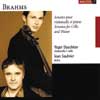Brahms Sonatas for Cello and Piano
The real cello sonatas, at least go well: but maybe Brahms is a bit bigger than this
View record and artist detailsRecord and Artist Details
Composer or Director: Johannes Brahms
Genre:
Chamber
Label: Analekta
Magazine Review Date: 11/2003
Media Format: CD or Download
Media Runtime: 79
Mastering:
Stereo
DDD
Catalogue Number: FL23167

Tracks:
| Composition | Artist Credit |
|---|---|
| Sonata for Cello and Piano No. 1 |
Johannes Brahms, Composer
Jean Saulnier, Piano Johannes Brahms, Composer Yegor Dyachkov, Cello |
| Sonata for Cello and Piano No. 2 |
Johannes Brahms, Composer
Jean Saulnier, Piano Johannes Brahms, Composer Yegor Dyachkov, Cello |
| Sonata for Violin and Piano No. 1 |
Johannes Brahms, Composer
Jean Saulnier, Piano Johannes Brahms, Composer Yegor Dyachkov, Cello |
Author: DuncanDruce
Polished, sensitive playing, well recorded; Dyachkov and Saulnier present Brahms’s musical argument with impressive clarity and understanding. After a time, however, I began to feel there was something missing, a lack of emotional involvement. Turning to Rostropovich and Serkin for comparison, I found that, despite a slower tempo, their account of Op 99’s first movement has far more of a sense of elation and grandeur – the intense way Rostropovich sustains the long notes in the opening theme contrasts with the almost baroque manner in which Dyachkov allows the sound to decay. The difference is just as marked in this sonata’s Adagio – Serkin and Rostropovich encompassing the music’s grand emotional sweep, Dyachkov and Saulnier, with their flowing speed and more delicate approach, somehow presenting a miniaturised version of the movement.
Some movements, however, are extremely successful – the Allegretto quasi Menuetto in Op 38, wistful and gracious, and two pieces where virtuoso panache comes to the fore – the finale of Op 38 and the Allegro passionato third movement of Op 99.
I have to confess to a dislike of the transcription for cello of the Op 78 violin sonata. The transposition, up or down, of the piano part from G to D major often destroys the effect of Brahms’s beautifully worked out keyboard sonorities, and changes of register in the cello part frequently sound unconvincing. This is also, I feel, a rather sleepy performance, of the outer movements, at any rate. A sense of constant motion is surely needed if the lyricism of this wonderful work is to take wing.
Some movements, however, are extremely successful – the Allegretto quasi Menuetto in Op 38, wistful and gracious, and two pieces where virtuoso panache comes to the fore – the finale of Op 38 and the Allegro passionato third movement of Op 99.
I have to confess to a dislike of the transcription for cello of the Op 78 violin sonata. The transposition, up or down, of the piano part from G to D major often destroys the effect of Brahms’s beautifully worked out keyboard sonorities, and changes of register in the cello part frequently sound unconvincing. This is also, I feel, a rather sleepy performance, of the outer movements, at any rate. A sense of constant motion is surely needed if the lyricism of this wonderful work is to take wing.
Discover the world's largest classical music catalogue with Presto Music.

Gramophone Digital Club
- Digital Edition
- Digital Archive
- Reviews Database
- Full website access
From £8.75 / month
Subscribe
Gramophone Full Club
- Print Edition
- Digital Edition
- Digital Archive
- Reviews Database
- Full website access
From £11.00 / month
Subscribe
If you are a library, university or other organisation that would be interested in an institutional subscription to Gramophone please click here for further information.




